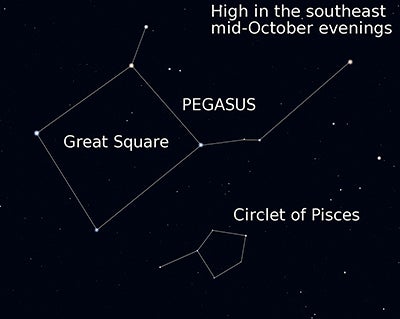Star Watch: With October comes a planet’s meeting
Published 7:01 am Sunday, October 1, 2017
By Deane Morrison
University of Minnesota
October is known for its clear, crisp weather, so let’s hope the pattern holds.
Mars joined Venus in the morning sky about a month ago. The red planet is climbing as Earth starts to catch up to it in the orbital race, while Venus is slowly dropping as it gets ready to sail behind the sun. On the 5th, the planets slip by each other, coming within half a moon’s width. Look low in the east about an hour before sunrise; Venus will be the slightly higher and brighter object.
While you’re at it, turn to the west to see the almost full moon getting ready to set, and take a gander at Orion and the other winter constellations in the south. Southeast of Orion’s hourglass form, Sirius, the brightest of stars, shines from Canis Major, the big dog.

Take flight with Pegasus. Photo provided
As Mars climbs higher, the waning moon approaches it. The morning of the 17th, one cusp of the crescent moon points to Mars. The next morning, a wisp of a moon rises below Venus to complete a stack of one moon and two planets. By the end of the month, Mars will be 16 degrees above Venus, with the planets continuing to widen their separation.
Jupiter disappears into the sunset in the first few days of the month, but fear not. The king of planets reappears in the morning sky next month, and just like Mars, it’ll pass close to Venus as it climbs. And because it climbs much faster than Mars, it sweeps very close to Mars, too; that happens in early January. All in all, morning viewers have plenty to look forward to.
The Orionid meteor shower is expected to peak in the early morning hours of the 21st or 22nd. These meteors are caused by bits of dust—left behind by Halley’s Comet—burning up in the atmosphere. Through most of October, Earth passes through a cloud of dust left behind by the comet, so you may see some meteors at other times. During the peak, though, we’re fortunate that no moon will interfere. From a dark site you may see 10 to 30 Orionid meteors per hour, radiating from a point near the club of Orion.
If you’re up before dawn late in the month, try looking to the east for the zodiacal light, a faint glow pointing up from the horizon along the sun’s path. This elusive shimmer is caused by sunlight reflecting off dust in the plane of the solar system.
The full harvest moon rises the evening of the 5th. Also in the evening, the Great Square of Pegasus rides high in the southeast or south. Below it, the Circlet of Pisces is fun to find, and that lone bright star low in the south is Fomalhaut, the mouth of Piscis Austrinus, the southern fish.
Contact: Deane Morrison, University Relations, (612) 624-2346,morri029@umn.edu
Find U of M astronomers and links to the world of astronomy athttp://www.astro.umn.edu.



